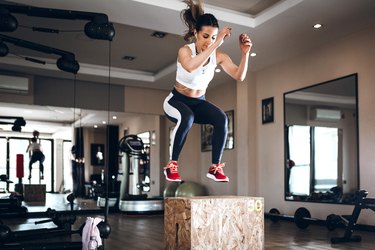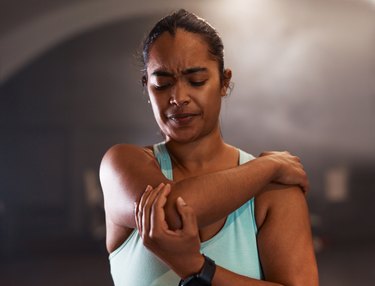


Got creaky and achy joints? If so, it's time to get moving. Staying active is important and benefits your entire body, including your joints. According to the American Academy of Orthopaedic Surgeons (AAOS), exercise has a slew of benefits, such as increasing blood flow to your joints bringing vital nutrients to them.
Regular exercise also helps maintain your weight, as added pounds can put more stress on your joints–especially your knees and hips. In addition, a July 2019 study in Osteoarthritis and Cartilage showed that exercise actually prevents cartilage breakdown in the joints of people living with osteoarthritis.
Video of the Day
Video of the Day
Make sure you are reaping the benefits of all of that hard work by avoiding these five exercise mistakes that could actually be harming your joints.
1. Skipping Strength Training
Cardio exercises, such as running or cycling, are great additions to your workout routine, but if you are skipping dedicated workouts to lifting weights, then you could be hurting your joints.
"Strength training is essential not only for aesthetic reasons but also for optimal health and longevity," says physical therapist Grayson Wickham PT, DPT, CSCS, founder of Movement Vault. "Being strong will help you decrease your chances of pain and injury. This is achieved by creating resilient joints. When all of the muscles that cross and surround a joint are mobile and strong, your injury and pain risk decreases significantly."
In addition, Wickham says that strength training increases your lean body mass which helps you burn more calories at rest. This translates into maintaining a healthy body weight to further decrease the stress on your joints.
Fix It
“Your muscles are the shock absorbers and prime movers for joints. Strength is key in making sure the load is controlled by the muscles, and not getting overloaded on the joint itself,” says board-certified sports specialist and physical therapist Leada Malek, PT DPT.
According to physical activity guidelines for adults, you should incorporate strength training into your routine at least twice a week. Focus on a full-body workout with compound movements, which work several muscle groups at the same time. Some examples include:
If you bump up strength training into three or four days, you could break up your workouts into upper body and lower body. Check out this upper-body dumbbell workout and a 5-minute leg workout to help get you started.
2. Skimping on Mobility
You are knocking out the cardio, adding in strength training, but are you taking the time to stretch? "Flexibility and mobility is the foundation for every movement you perform in life, in the gym or in sport," Wickham says. "When an exercise demands that your joints move in a certain position, but you have tight muscles and joints, you won't able to do that movement correctly with good form."
As a result, your joints will have to compensate for this immobility, causing wear and tear and eventually pain and injury. A good example of how immobility or poor flexibility can lead to an injury is doing a squat.
"The squat requires that you have adequate ankle and hip mobility. If your ankles and/or hips are tight, your knees and low back will have to compensate for your tight ankles and hips. This is one of the primary causes of injury in your knees and low back," he explains.
Fix It
One great way to work on your flexibility is by incorporating yoga into your exercise routine. Yoga not only increases your flexibility, but it's a low-impact way to strengthen your muscles.
“Having great flexibility and mobility is the number one way to reduce your risk for pain and injury. It will also increase your performance, as you will be able to perform exercises correctly with good form that is not hampered by your tight muscles and joints," Wickham says.
If you aren’t a fan of yoga, take your body through a series of stretches a few times a week. This 20-minute full-body stretching routine is a great way to start. You can use a foam roller while stretching to work out muscle knots and to help warm up your muscles before a workout.
A dynamic stretching routine is also beneficial to add to your exercise program. These types of stretches not only increase flexibility but are an effective way to get your muscles firing and primed for a workout.
3. Only Doing High-Impact Exercise
For optimal joint health, you should be mixing up your exercise routine between high-impact and low-impact exercises. For example, doing five days in a row of high-intensity interval training (HIIT) or running three miles every day is not only be hard on your joints, but it also doesn't allow your body to reap the full benefits of exercise.
In fact, only doing high-impact exercises can eventually cause wear-and-tear damage to your joints. A June 2017 study in the Journal of Orthopaedic and Sports Physical Therapy showed that high exposure to high-impact activities, like running, increases your risk for hip and knee osteoarthritis.
On the other hand, if you only do low-impact exercises, like cycling or swimming, you are missing out on the bone-strengthening benefits of high-impact exercise and strength training. The key is moderation and alternating your exercises.
Mixing up your routine also challenges your body so you continue to make gains. "If you consistently perform the same exercises at the same intensity, you will eventually plateau and your strength, muscle and cardiovascular gains will stop progressing," Wickham says.
Fix It
To give your joints a rest, mix up your routine between high-impact activities, such as HIIT and running, and low-impact activities, such as Pilates, swimming and cycling.
When strength training, mix up the type of exercises you do and make sure you constantly challenge yourself with how much weight you are lifting through progressive overload.
“Our body adapts to new stimuli placed on it, so if you want to continue making progress, remember to keep things interesting for you and your body,” Malek says. This means not only switching up the type of exercise you do but also the reps and weights you use.
How do you know when it's time to lift heavier weights? A good rule of thumb is if you can easily do the last few reps without much effort, it's time to go up in weights to continue to get stronger and make gains.
4. Avoiding Rest Days
Just like not varying your workouts enough, not taking any rest days can also hurt your joints. It is important to take a day to rest, recover and recharge. Doctors orders!
"Adequate recovery is essential because exercising causes stress to your nervous system, and physical stress to your connective tissues, such as your muscles, fascia and tendons," Wickham explains.
This damage then needs time to heal properly, so limiting stress on your nervous system and connective tissues during your rest days allows them to recover and repair.
Fix It
The American Council on Exercise recommends taking one day of rest from demanding physical activity every seven to 10 days.
“Overreaching can turn into overtraining and increase the risk of injury. When the body doesn't get a chance to recover, it is less efficient at managing the load placed on it. If the muscles aren't performing as well, your tendons and joints may feel it,” Malek says.
Feel free to take a leisurely stroll or do some gentle stretches, but make sure you take one day to rest from any high-energy exercises or strength training. You’ve earned it.
5. Wearing the Wrong Shoes
Depending on the exercise you're doing and your natural foot shape, wearing the wrong type of shoe can hurt your joints.
"It's important to wear shoes that match your ability and exercise choice," Malek says. This is especially important if you don't have the proper foot strength and are going to be increasing exercise.
The Mayo Clinic explains that your shoes should conform to the shape of your feet. You should not force your feet to conform to a pair of shoes.
For example, if you have high arches and are doing a high-impact exercise, like running, make sure you find a shoe that supports your arch to avoid joint injury. If you have a low arch or flat feet, the Mayo Clinic recommends a shoe with motion control to prevent joint injury.
Other considerations in a shoe include how much cushion you need, as many shoes have air, gel or foam to help absorb the shock to protect your joints.
Fix It
To build up strength and mobility in your feet, Wickham says you should actually make a point of going barefoot around the house when not exercising. Spending time barefoot helps you increase the strength and mobility in your feet.
“Most people have very poor foot and ankle strength and mobility. This is due to years and decades of wearing shoes with far too much cushioning and too much arch support that are too narrow, and have too high of a heel lift,” he says. “This leads to feet that don’t work as they should."
Wickham also says that the type of workout you do should dictate what type of shoes you are wearing. For those that are doing explosive jumping or lateral movements, such as a bootcamp or HIIT class, he recommends a shoe with lateral support and moderate cushioning. If you are weightlifting, look for shoes that have a rigid sole with a heel lift.
In general, however, he recommends wearing minimalist footwear to build up the strength in your feet, so they can do their job of protecting your joints.
“Minimalist footwear is a shoe that has a wide toe box, no heel lift and minimal cushioning. This allows your feet to move the way they should. Minimalist footwear is perfect for most workouts performed in the gym and even shorter runs,” he says.
You can also see a podiatrist or a shoe expert at a specialty shoe store who can assess your arch and foot type and offer a recommendation.
- American Academy of Orthopaedic Surgeons: "Managing Arthritis Pain With Exercise"
- Osteoarthritis and Cartilage: "Mechanical Loading Inhibits Cartilage Inflammatory Signalling via an hdac6 and Ift-dependent Mechanism Regulating Primary Cilia Elongation"
- Journal of Orthopaedic and Sports Physical Therapy: "The Association of Recreational and Competitive Running With Hip and Knee Osteoarthritis: A Systematic Review and Meta-analysis"
- The American Council on Exercise: "8 Reasons to Take a Rest Day"
- Mayo Clinic: "Walking Shoes: Features and Fit That Keep You Moving"